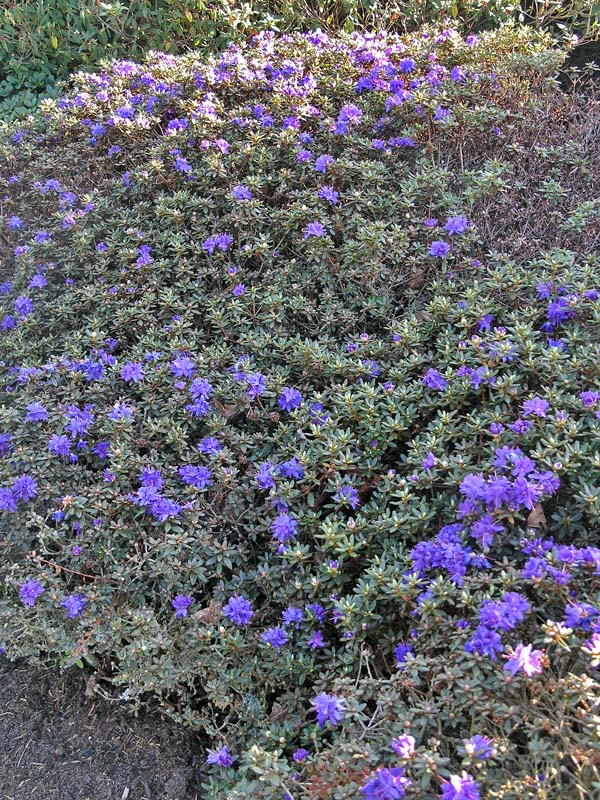
Woody > Rhododendron > Rhododendron 'Azurika'
Rhododendron
'Azurika'
Azurika Rhododendron
Origin: A hybrid of R. russatum and R. impeditum that was bred by H. Hachmann, Barmsledt, Germany in 1963.
Mike's
Opinion


"
Rhododendron 'Azurika' is not a very well known plant due to it being a hybrid. As Michael Dirr stated: "Rest assured that even the experts do not know the rhododendron genus in its broadest sense" (Dirr 950). 'Azurika is a cross between R. russatum and R. impeditum. A stunning small dwarf plant, it blooms with beautiful violet flowers for an extended period of time, as well as it is fairly adaptable and quite tough to a variety of climate and site conditions.
Michael Pascoe, NDP., ODH., CLT., MSc. (Plant Conservation)
"
| Family |
| Ericaceae |
| Genus |
| Rhododendron |
| Cultivar |
| 'Azurika' |
| Category |
| Woody |
| Type |
| Shrub (deciduous), Shrub (evergreen) |
| USDA Hardiness Zone |
| 7-9 |
| Canadian Hardiness Zone |
| 8-10 |
| Temperature (°C) |
| -22 |
| Temperature (°F) |
| -8 |
| Height |
| Can reach up to 95 cm in 10 years |
| Spread |
| Wide spread, compact growing (1 m) |
Photographs
Description and Growing Information
Flowering Period
| General Description |
| Dwarf shrub, dark leaves (small), the twigs and stems are all very small and hidden in the foliage. Extremely floriferous (multiple trusses on many branches), compact growth, low growing and fairly large spreading. |
| Landscape |
| Used in shade and woodland areas because of its part sun/part shade tolerance. Due to it being a dwarf variety and its low-spreading nature, it is not the focus of a garden, but rather, a lovely accent for dimension and colour. Stunning deep purples add a nice contrast to the dark evergreen leaves. |
| Cultivation |
| 'Azurika' needs to be constantly moist but requires good drainage. Planting in windy areas, exposed situations and heavy shade should be avoided. |
| Shape |
| Compact, shrub, horizontal, low growing. |
| Growth |
| Slow |
| ID Characteristic |
| A small, evergreen shrub with compact growth and small, dark-green waxy leaves. Deep purple/violet large ruffled trumpet-like flowers, appear in the late spring. |
| Pests |
| May be prone to: root weevil, aphids, bark scale, caterpillars, leaf rollers, sawflies, leaf miner, spider mites, lace bugs, white fly, slugs and snails. |
| Habitat |
| Horticultural origin. |
| Bark/Stem Description |
| Dark milk-chocolate brown, fairly smooth with some rimmed texture. |
| Flower/Leaf Bud Description |
| Green, compacted bud scales (small) located at center of palm of leaves, 2 cm long. |
| Leaf Description |
| Small, long, oval-shaped, with a large defined vein through the centre. Smooth, almost waxy-looking, and fairly dark green and pointed at the tip. Close to 3 cm in length. |
| Flower Description |
| Dark blue to violet flowers (April-May deepest colour). Flowers are single but in tight clusters, prominent, funnel shaped, 3 cm long and 2 cm wide. |
| Fruit Description |
| Small curved seeds located in long oval seed pods |
| Colour Description |
| Dark green in non-flowering months, stunning purple in late spring, early summer |
| Texture Description |
| Fine to medium coarse texture |
| Notable Specimens |
| Wakehurst Place, Ardingly, West Sussex, England. |
| Propagation |
| Rhododendrons can be propagated by cuttings, grafting, layering (pinning a low branch to the ground) or tissue culture. |
References
Brickell, Christopher and Trevor Cole, eds. 'Canadian Encyclopedia Plants and Flowers.' Canada: Dorling Kindersley 2001.
Dirr, Michael. 'Manual of Woody Landscape Plants.' Champaign, Illinois: Stipes Publishing, 2009.
Ontario. Ministry of Agriculture and Food. Publication 45: 'Rhododendrons and Azaleas.' Web. 19 Oct 2013.
Taylor, Norman, ed. Taylor�s Encyclopedia of Gardening. U.S.A.: Houghton Mifflin, 1961.

